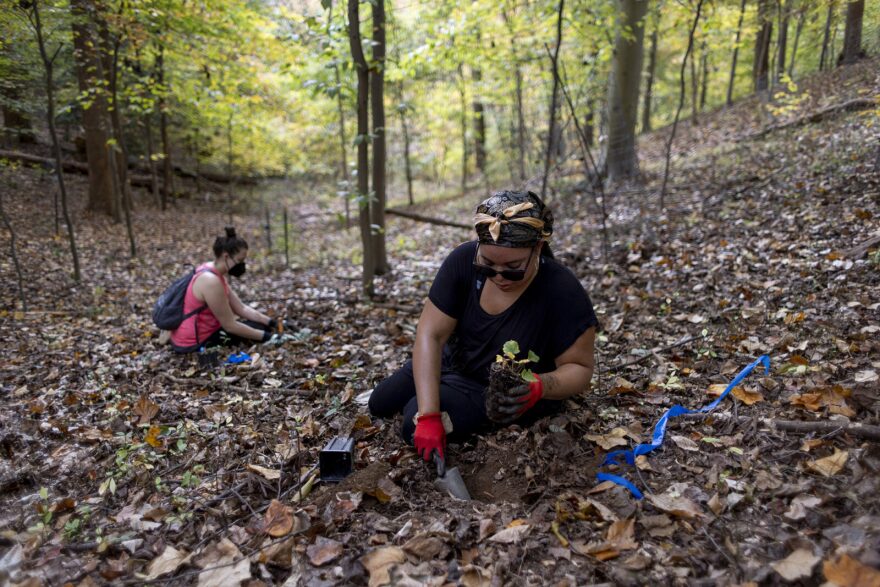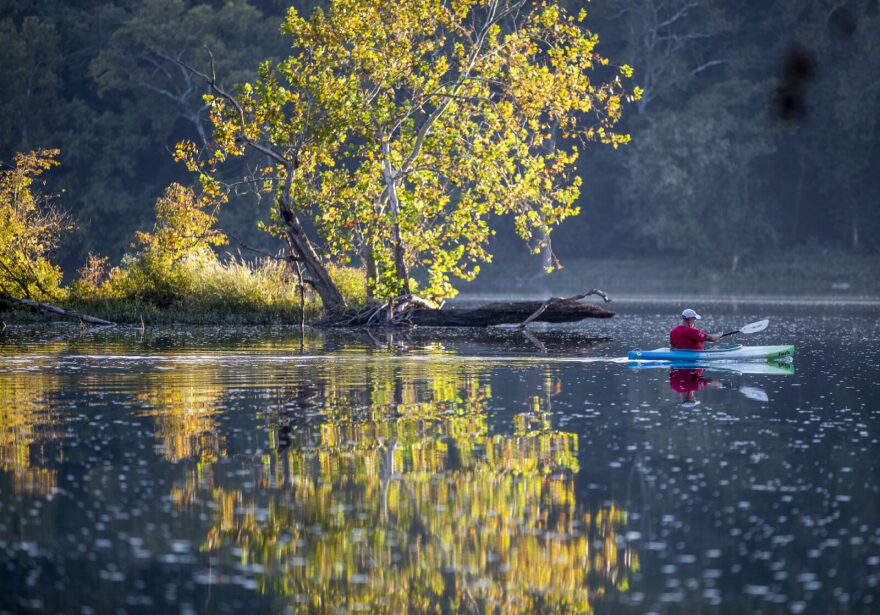Read the original story on DCist/WAMU's website.
Up and down the East Coast, forests are in trouble — under attack by pests, invasive plants, overabundant deer, and stressed by climate change.
In fact, in 90% of D.C.-area national parks, forests are failing to produce the next generation of trees, and could see widespread forest loss in the coming decades.
But the trend is not irreversible.
Some environmental problems seem diffuse and global and hard to move the needle as an individual — think microplastics or air pollution or greenhouse gas emissions. But when it comes to forest health: Put on some gloves and boots and you can have a noticeable impact with a few hours of work.
“We need to more hyper-local activists who understand the value of urban forests,” says Nathan Harrington, founder and director of the nonprofit Ward 8 Woods Conservancy. “Start with your own home. Are trees being smothered by invasive vines? Cut them back. Then move on to nearby parks.”
Here are five things you can do to help save local forests.

Stop the plant invasion, choose natives
Many of the invasive vines and shrubs that are running amok and ravaging local ecosystems were brought here on purpose as ornamental plants. It might be surprising just how many are still for sale at garden centers and nurseries.
English ivy, Japanese wisteria, Japanese barberry, winged burning bush, to name just a few — these are some of the worst offenders and are easily found for sale. Even porcelainberry — which blankets and smothers forests along many roads — can be purchased.
If you live far from a forest, it might seem harmless enough to plant these in the confines of your property. But the seeds can be dispersed by birds, or even by clinging to your shoes or clothing.
These invasive plants are popular for a reason: they’re extremely easy to grow, they’re deer resistant, and they have beautiful traits — whether flowers or fall foliage. In all cases though, there are native alternatives that won’t get out of control. Plant American wisteria, rather than the Asian varieties, for example, or trumpet honeysuckle instead of Japanese honeysuckle.
“Barberry is one the most problematic invasive plants in our park because it quickly outcompetes native plants,” says Lindsey Donaldson, chief of resource management at Catoctin Mountain Park. “It was likely introduced as a landscape shrub around homes because of its colorful foliage and fruit. Unfortunately, it is still sold today at department stores and nurseries.”
There are many online resources to help figure out what to plant, including lists of native alternatives to popular invasives, and lists of native plants that do well in the mid-Atlantic. Many garden centers now feature sections devoted to native plants, and there are several local nurseries that only sell natives.
These include:
- Richmond: Plant RVA Natives, while not a nursery, keeps a handy list of Central Virginia native plant sellers
- Alexandria: Green Spring Gardens
- Springfield: Earth Sangha’s Wild Plant Nursery
- Bethesda: Wildflower Native Plant Nursery
- D.C.: There are also various native plant sales during the planting season, including at the National Arboretum.
In D.C., the city will pay for native landscaping (or “bayscaping“), through its RiverSmart Homes program. Be warned, though, there is a long waiting list. The program also provides free plantings of native trees.
Of course, not all non-native plants are invasive, so no need to yank out your favorite hydrangeas or peonies. However, harmless non-native plants don’t provide the same benefits to wildlife that native plants do.
If you live in an apartment or condo building, look around at the landscaping. Is English ivy climbing the trees? If so, it could kill them, and also help ivy spread to nearby woodlands. Is the outdoor space dominated by turf and mulch? Advocate for introducing native species.

Volunteer in your local park and wage war on weeds
Getting invasive plants out of public lands is a big job, and it’s labor intensive. The National Park Service and local governments have tiny staffs devoted to the gargantuan task, so much of the work falls to volunteers.
Volunteer with a group, or get trained as a “weed warrior” so you can attack invasive plants on your own. But don’t do it without proper instruction: some native plants look similar to natives. For example, it’s easy to mistake porcelainberry for native grape vines. English ivy often grows near native poison ivy. Native vines don’t harm trees, and should not be removed.
Wherever you live, there is likely a friends group or other nonprofit at work in your local forest.
- The Anacostia Watershed Society holds various volunteer events in the watershed throughout the year, including tree plantings.
- Friend of Anacostia Park holds cleanups in Anacostia Park.
- Rock Creek Conservancy holds regular invasive plant removals and native planting events. The organization also trains weed warriors, so you can get approval to attack invasives on your on park land.
- Ward 8 Woods hosts regular cleanups in parks east of the Anacostia River, including Fort Stanton Park and Shepherd Parkway.

Overcome ‘plant blindness’
There is a phenomenon known as plant blindness — a term coined by two researchers in 1998, it refers to “the inability to see or notice the plants in one’s own environment.” This leads to a failure to “recognize the importance of plants in the biosphere and in human affairs.”
Without seeing and understanding the plant world, it’s impossible to see what’s going wrong and how to fix it. Once you start learning the names and shapes of common invasive plants, you will see them everywhere.
This free, downloadable book from the National Park Service and U.S. Fish and Wildlife Service is the authoritative guide to invasive plants in the region.
“When I walk through the woods in the early spring, late winter, people are like, ‘Oh, it’s so lush and green,'” says Jeanne Braha, executive director of Rock Creek Conservancy. People don’t realize, she says, that they’re looking at lesser celandine, an invasive perennial that creates a thick mat of green early in the growing season, blocking the growth of native wildflowers.
“Really starting to wake people up to what is happening is a great way to get people to start thinking about the future they want for these forests,” Braha says.
Learn your local native plants. Start with trees — they’re big! And just a few species dominate forests in the region. Once you can spot American beech, white oak, and tulip poplar, you can identify most of the trees in many local parks. This brief guide shows the leaf of just about any tree — native or non-native — that you may encounter in the region.

Advocate for laws that protect forests
Want to buy English ivy in Oregon? Too bad! Chinese wisteria in Delaware? Nope!
Laws on invasive plants differ by state — some states have long lists of banned plants. In Maryland, there are currently six invasive plants that may not be sold, including lesser celandine and Amur honeysuckle, and there are 13 invasive plants that can only be sold with a sign warning of their invasive nature.
Legislation passed in 2022 will soon greatly expand that list. It requires state officials to either ban or require warnings for the dozens of other invasive plants featured in the NPS and USFWS guide.
In D.C. there’s proposed legislation that would create a new office dedicated to rooting out invasive plants, and new staff focused on conserving natural areas.
And in Virginia, legislation was passed early in 2023 requiring officials to create a list of invasive plants by January 2024. State agencies will be banning from planting species on the list, and officials may impose additional restrictions and permitting requirements.
Strengthening laws targeting invasives could go a long way toward keeping the plants out of forests, especially if the policies are similar across the region.

Get out and enjoy the woods
The more people appreciate and value the forests, the more they will be cared for. In the D.C. area, there are many small bits of forest scattered through the urban landscape, and they often go under-appreciated and unmaintained.
Try forest bathing — the Japanese practice of experiencing and appreciating nature, known as “shinrin-yoku.”
And spend time in the woods with your kids — the next generation of humans will be stewards of the next generation of trees.



